What happened to the days when all you had to worry about was the amount of water you drank? Now, we have to think about contaminants in our water such as bacteria, parasites, and unwanted chemicals. But even if your drinking water is deemed to be “safe,” that doesn’t mean it’s beneficial to your health or provides you with the essential minerals your body needs.
Not all water is the same. Some natural groundwater is higher in minerals such as calcium, which is considered ‘hard’ water. There is no harm in drinking hard water, but it is hard on your appliances, causing calcium buildup. A water softener may be required to soften the water, but that makes it not as good for drinking.
Other waters from springs or wells may naturally have a good balance of minerals and electrolytes, resulting in a good taste. As long as it hasn’t been contaminated through processing, this would be the ideal type of water to drink.

Tap Water
Tap water originates from groundwater or a stream, and goes through a multi-step purification process before it ever reaches your pipes. Sediments and solids are easily removed. Unfortunately, most states allow the addition of harmful chemicals for purification, and some chemical contaminants are not easily removed through processing.
The purification process treats the water and brings it to local testing standards. But there are also potential risks with tap water, because many contaminants are not regulated or looked for through testing.
Potential problems:
- The purification process strips the water of many of its original minerals
- Contamination can occur with decades-old lead pipes
- Subject to chemicals and toxins seeping into the groundwater from industrial spills and agriculture
- Added chemicals through purification, such as fluoride and chlorine
Each one of the above items can impact the quality of your tap water. Both groundwater and surface water bodies are showing increasing levels of contamination. Heavy metals and chemicals from pesticides, oil, and fertilizers seep through our soil into the groundwater far below the surface.
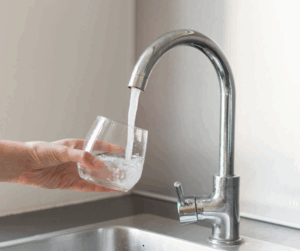
Bottled Water
Before you decide that tap water is too risky and switch over to bottled – there are a few things you need to know. Let’s take a look at the differences.
Bottled water is classified as food by the FDA. There are rules about the amount and number of contaminants allowed. But there is no mandatory testing required. That means if your water is contaminated, you won’t know about it until after you buy it.
Bottled water can be easily contaminated during the packaging process. The bottles also contain tiny bits of plastic debris known as microplastics. These microplastics have been linked to:
- Changes to your hormonal system
- Digestive dysfunctions
- Cancer
- Respiratory issues
- Skin issues
- Problem with brain development
If you must buy bottled water, pay close attention to the source. Try to stick to water that’s from a naturally occurring source – like mineral water or water that comes directly from the spring and has been tested, not purified, or processed. Even better, look for water such as Mountain Valley Spring water, which is bottled in glass.
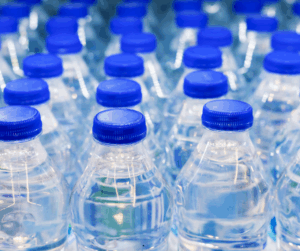
Mineral Water
Mineral water comes from protected underground sources. It’s rich in minerals like sodium, magnesium, potassium, and calcium.
Mineral water can help with heart health by helping lower blood pressure and decrease constipation. You can make your own mineral water by adding natural sea salts to distilled water. Mineral rich and pure, as well!
Regardless of which water you’re currently drinking, each one has its pros and cons. The best way to make sure your water is safe is to have it tested and if needed, install a home filtration system.
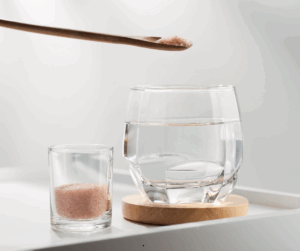
Which Water Filter System Should I Use?
Deciding which type of water filtration system will work best for you depends on what’s in your water. There are a few ways water filters can help:
- They can remove excess chlorine
- They can remove sediment and other impurities
- They can be more aggressive and remove unwanted chemicals, herbicides, pesticides, heavy metals, and iron
- They can remove calcium to reduce the impact of hard water
In our opinion, the best option is a whole-house water filter, which is installed at the point where water comes in to your house. You could also choose one or multiple stand-alone unit(s) that filters water coming out of an individual faucet or shower. These can sit above the counter or be mounted under the sink.
Let’s take a deeper look at the three main types of water filters…
Activated Carbon Filters
As the name implies, this type of filter uses activated carbon to remove impurities from the water. A good example of this type of filter is the well-known Brita pitcher. These work best for removing chlorine, VOCs (volatile organic compounds), and any sediment that may be in the water. Activated carbon filters are popular, easy to use, and economical.
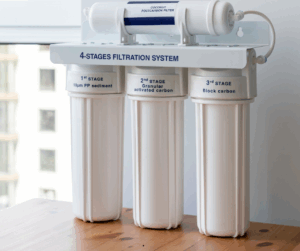
Reverse Osmosis
Reverse osmosis (RO) filters are highly effective for removing fluoride, heavy metals, and other dissolved solids in the water. Selective or Partial RO systems are designed to selectively remove certain impurities while leaving beneficial minerals in the water. RO filters can be installed as a whole house filter, free-standing, or mounted under the sink. They will usually require professional assistance to install which can add to the overall cost. We have an Aquasana RO system at our house.
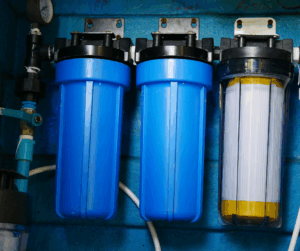
Ceramic Filter
A ceramic filter is a porous device made from natural materials like diatomaceous earth or clay, which is kiln-fired to create a fine, hard shell full of microscopic pores. These pores, typically between 0.2 and 0.9 microns, physically trap bacteria, protozoa, sediment, and debris, making ceramic filters highly effective at removing pathogens like E. coli, Giardia, and Cryptosporidium. Many ceramic filters also contain silver, which inhibits bacterial growth within the filter itself. Some models include a carbon core or additional media inside the ceramic shell to reduce chlorine, pesticides, VOCs, and improve taste and odor.
In the U.S., several high-quality ceramic filters are widely available. Doulton® and British Berkefeld® are internationally recognized brands; both are manufactured in the UK and distributed here. Other systems include: AquaCera®, ProOne®, and Radiant Life®. These filters are often compatible with gravity-fed systems and countertop dispensers, making them an attractive for those seeking effective filtration with robust microbiological protection.
Quick Comparison
When comparing ceramic filtration to reverse osmosis (RO), the two serve different purposes. RO systems use high pressure and a semi-permeable membrane to remove nearly all dissolved solids, including fluoride, nitrates, heavy metals, and salts. While this creates ultra-purified water, RO also strips beneficial minerals and often requires re-mineralization.
Ceramic filters, by contrast, retain natural minerals and preserve water structure while offering strong microbial protection. They don’t remove as many dissolved contaminants as RO, but for many people, ceramic filtration offers a more natural-tasting, mineral-rich water with fewer system complexities and no wastewater.
Overall, ceramic filters provide excellent water quality for most everyday needs, particularly when the goal is microbial safety, chemical reduction, and mineral retention without the maintenance burden of RO.

Clean Water On-the-Go for Good Hydration
If you love to hike and camp, it may be hard to bring enough filtered water with you. Fortunately, we have several options to help you keep your drinking water safe while you’re on the go, enjoying the outdoors…
Water Purification Tablets
This is one of the easiest ways to ensure you always have clean drinking water, free from the little bugs and critters that might want to make you sick while traveling. They are affordable and easy to take along however, they typically use chlorine or iodine to kill bacteria and viruses in the water. But that’s not necessarily a bad thing when you compare it to having severe intestinal illness from drinking impure water. All you have to do is drop a tablet into a container of water and wait for the recommended amount of time before drinking.

Portable Water Filters
Portable water filters are just as their name implies – highly portable. They can easily travel with you while hiking, camping, and enjoying other outdoor activities. One of the most popular and well-known brands is the LifeStraw Personal Water Filter. These filters are highly effective and inexpensive making them a great option when traveling outdoors. A great gift for your favorite hiker!
Hydration is Essential for Your Health
No matter which type of filtration system you use to ensure your drinking water is as clean as possible, here are a few additional options to make your water more enjoyable and better for you:
- Re-mineralize your water at home by adding trace mineral drops or pink Himalayan salt
- Add fun elements to your water such as: lemon, berries, cucumbers, mint, or watermelon
- Use your clean water for a cup of organic herbal tea

Minerals for the Win!
Do you feel like the more you drink, the more you pee? Who has time for that? The problem could be a lack of minerals. That’s right, minerals help your cells properly balance water inside and outside the cell membrane. You don’t want an excess of any one particular mineral, but rather, a good balance of all of them. That’s why we often suggest taking a whole-food based supplement, with lots of minerals!
- Trace Minerals B12 – as a good source of iron, vitamin B12, iodine, zinc, copper, and manganese, this product helps to activate enzymes and many trace mineral-dependent processes in the body. These all play indirect but crucial roles in maintaining cellular hydration, electrolyte balance, and fluid transport.
- Organically Bound Minerals – is a rich source of potassium derived from kelp and alfalfa. Potassium is good to ease a racing heart, to calm the nervous system, and to regulate the fluid balance inside your cells. A good addition for kidney and adrenal support, as long as you’re not on blood pressure meds.
- Biotics Electrolyte Forte – provides taurine, which helps to maintain osmotic balance and modulates the movement of electrolytes in and out of cells. Also provides sodium, vitamin C, calcium, phosphorus, magnesium, chloride, and potassium. Good for athletes or anyone outside sweating a lot.

Bottom Line
Ensuring the water you drink is as safe as possible should be at the top of your priority list. If needed, start with a countertop Berkey or under the sink filter. Having clean water doesn’t have to be expensive or complicated.
Just choose the water filter that best suits your situation and your budget and start drinking more water right away!


